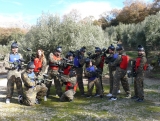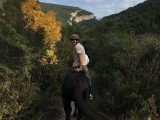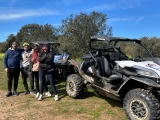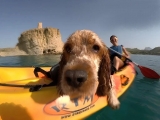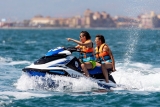Introduction
Colombia is a wonderful country for scuba diving. Its geography, beautiful seas, and surroundings make this sport unparalleled and indescribable. With access to two oceans—the Atlantic and the Pacific—the magic of diving is limitless, and its waters offer opportunities to explore various specialties such as wreck diving, drift diving, cave diving, deep diving, night diving, naturalist diving, altitude diving, underwater photography, videography, and multilevel diving, among others.
Additionally, diving in Colombia has not yet become mass tourism. It is comfortable and enjoyable to practise, as diving professionals always work with small groups and ensure safety, even during peak season.
Furthermore, the diving destinations in the Pacific and the Caribbean remain largely pristine and well-preserved thanks to strict oversight by the Ministry of Environment over coral reefs and Natural Parks.
In the Pacific Ocean, divers can encounter abundant and large marine wildlife—a phenomenon driven by the high plankton content in its waters, which supports a rich food chain. Meanwhile, the Caribbean Sea boasts exuberant coral formations. Rich in sponges and home to an exotic variety of species, it is a truly marvellous underwater universe.
In the Caribbean, dive sites are located in major tourist destinations such as Cartagena, Santa Marta, and San Andrés. In the Pacific, although there are dive centres and accommodations in places like Bahía Solano, Nuquí, Gorgona, and Malpelo, specialised boats must be chartered, and divers often stay on board. It is worth noting that most of these destinations have modern hyperbaric chambers for treating diving-related injuries.
In the Caribbean, these chambers are located in San Andrés, Cartagena, and Santa Marta. In the Pacific, there is a chamber in Bahía Málaga, installed at a National Navy operations base, allowing access from all dive sites in the area via helicopter. Even in the most remote coastal locations, communication systems enable air transport within approximately thirty minutes.

Top Dive Destinations in the Caribbean Sea (Atlantic Ocean)
- Isla Fuerte:
Location: Latitude N 9°24’, Longitude W 76°11’. Climate: Tropical. Temperature: 28°C. Access: By sea from anywhere in the Gulf of Morrosquillo.
Diving: The island features an underwater ridge extending from Punta Barú, hosting significant coral formations at depths between 6 and 36 metres. Divers encounter diverse reef fauna, including barracudas, snappers, jacks, groupers, sea bass, rays, and various sponge species. Services include tank refills, boat rentals, equipment hire, training, and guided excursions.
- Islas del Rosario:
Location: Latitude N 10°11’, Longitude W 75°48’. Climate: Tropical. Temperature: 28°C. Access: By air via Avianca, Sam, Aces, and AeroRepública flights to Cartagena, or by road from major Colombian cities.
Diving: The underwater landscape is uniquely beautiful and diverse, home to the most varied coral community along Colombia’s Caribbean coast. Over 50 coral species, 197 molluscs, and 215 fish species have been recorded. There are more than 30 dive sites, including three wrecks. This is a Natural National Park, managed by the Ministry of Environment, with strict regulations and protected zones.
- Tayrona Park:
Diving: Numerous coral formations extend to depths of 36 metres. The underwater profile is steep, allowing access to deep waters close to shore. Wildlife includes pufferfish, sea bass, sawfish, sharks, and seahorses. Caution is advised due to strong currents and waves.
- San Andrés Island:
Diving: Diving in San Andrés is a true pleasure. Optimal conditions, pleasant water temperatures, excellent visibility, and diverse coral reefs, walls, cliffs, wrecks, and caves make for an incomparable experience. Marine life is abundant, colourful, large, and non-aggressive. The island has reputable dive schools, instructors, modern equipment, and one of Latin America’s most advanced hyperbaric chambers.

- Providencia:
Diving: The island’s barrier reef is Colombia’s largest (20 km long and up to 600 m wide). The stunning variety of coral species and associated marine life creates an indescribable sense of fascination.
In addition to typical reef fauna, divers encounter large species such as grey reef sharks, hammerheads, dolphins, groupers, and snappers. Crystal-clear, warm waters, wrecks, and caves enhance the experience.
Top Dive Destinations in the Pacific Ocean
- Gorgona Island:
Diving: Oceanographic conditions—relatively clear waters, high salinity, and temperatures around 23°C—along with rocky seabeds, have fostered one of the best-developed coral reefs in the American Pacific. Dive sites are designated by park authorities. The island has a dive centre offering training, equipment rental, air compressors, and boats.
Its wildlife is abundant, large, and diverse: whitetip reef sharks, rays, eagle rays, turtles, snappers, moray eels, and dolphins. From June to early November, humpback whales visit the island’s warm waters to calve—an awe-inspiring spectacle. Boats may approach no closer than 300 metres.
- Malpelo:
Diving: The island is a rocky mass with near-vertical cliffs plunging from sea level to 90 metres. Depths reach 120 metres, with abundant underwater caves and grottos. Visibility is exceptional. A major highlight is the remarkable hammerhead shark population—one of the world’s best spots to observe this species. Divers may also encounter whale sharks, manta rays, trumpetfish, barracudas, snappers, groupers, sea bass, turtles, morays, and dolphins.

Malpelo Island is ranked among the world’s top ten dive sites.
- Nuquí:
Diving: Rocky seabed, small coral reefs, and highly diverse, colourful marine life with large schools of fish. The best diving season runs from March to August. The area has well-equipped dive centres. From Nuquí, visitors may also witness humpback whales; special observation programmes are available. Orcas occasionally visit.
- Capurganá:
Diving: Coral reef formations and stunning underwater landscapes, notable for their pristine condition. Snorkelling and scuba diving are available, with services including training, tank refills, equipment rental, and boat hire.
- Bahía Solano:
Diving: Deep-water diving with rocky seabeds and abundant, large marine life. Some coral ecosystems are present. Dive shops offer equipment rental, guided dives, and air compressors. Tube-shaped corals, which extend their polyps only at night, create a striking yellow "garden" effect.
In Summary
Certified divers are fortunate to have access to a vast array of dive sites, attracting growing numbers to this sport, which in Colombia is taught and practised with high professionalism, adhering to international standards.
Few foreign divers visit, as the country’s diving scene remains underpromoted globally. However, European divers and operators—particularly from Germany, Switzerland, and Italy—are increasingly choosing Colombia as a preferred diving destination. Some Europeans, captivated by the landscapes and culture, have even settled here to open dive centres.

Additionally, most dive centres offer courses in Spanish or English, with some providing instruction in Italian, German, Portuguese, or French.
Recreational diving is a growing industry in Colombia, evidenced by annual dive expos, local equipment manufacturing, and increasing media coverage. More travel agencies and hotels now offer specialised dive packages. Colombia is, in short, an unexplored paradise for underwater adventurers.
Diving Tips
- Tides. When diving near the coast, tidal ranges can be critical. In some areas, like Colombia’s Pacific coast, tides can exceed four metres. This affects boat passage and requires caution during entry/exit and with shore-left equipment. On the Caribbean coast, tidal variation is minimal (~50 cm), but the Pacific’s 4-metre range exposes or submerges vast areas dramatically.

- Sponges and Octocorals. These organisms’ growth reflects nutrient availability and currents. Flattened, hydrodynamic sponges indicate strong currents, while expansive octocorals suggest gentler flows, as they maximise nutrient capture.
- Precautions. Beware of seemingly harmless organisms that can spoil a dive. Some soft corals, like fire coral, pose risks—especially when diving without a full wetsuit. Sudden currents may force divers to grip substrates, making gloves essential.
- Jellyfish. If stung, avoid rubbing—untriggered nematocysts may worsen irritation. Rinsing with vinegar or saltwater is preferable.

To prevent mask fogging, apply a small amount of toothpaste to both sides of the lens.
After rinsing gear post-dive, apply talcum powder to rubber/silicone parts during storage to prolong their condition.





